Ferdinand I of Bulgaria
| Ferdinand I | |
|---|---|
 | |
| Tsar of Bulgaria | |
| Reign | 5 October 1908 – 3 October 1918 |
| Successor | Boris III |
| Prince of Bulgaria | |
| Reign | 7 July 1887 – 5 October 1908 |
| Predecessor | Alexander |
| Born |
26 February 1861 Vienna, Austrian Empire |
| Died |
10 September 1948 (aged 87) Coburg, Allied-occupied Germany |
| Burial | St. Augustin, Coburg |
| Consort |
Princess Marie Louise of Bourbon-Parma Eleonore Reuss of Köstritz |
| Issue |
Tsar Boris III Kiril, Prince of Preslav Princess Eudoxia Princess Nadezhda |
| House | Saxe-Coburg and Gotha-Koháry |
| Father | Prince August of Saxe-Coburg and Gotha |
| Mother | Princess Clémentine of Orléans |
| Religion | Roman Catholicism |
| Signature |
 |
Ferdinand I (Bulgarian: Фердинанд I Български, 26 February 1861 – 10 September 1948),[1] born Ferdinand Maximilian Karl Leopold Maria of Saxe-Coburg and Gotha, was the ruler of Bulgaria from 1887 to 1918; firstly as knyaz (ruling prince, 1887–1908) and later as tsar (king, 1908–18). He was also an author, botanist, entomologist and philatelist.
Family background
Ferdinand was born on 26 February 1861 in Vienna, a prince of the House of Saxe-Coburg and Gotha-Koháry. He was baptised in St. Stephen's Cathedral, Vienna on 27 February, having as godparents Emperor Maximilian of Mexico and his wife Empress Carlota of Mexico.[2] He grew up in the cosmopolitan environment of Austro-Hungarian high nobility and also in their ancestral lands in Slovakia and in Germany. The Koháry descended from an immensely wealthy Upper Hungarian noble family, who held the princely lands of Čabraď and Sitno in Slovakia, among others. The family's property was augmented by Clémentine of Orléans' remarkable dowry.
The son of Prince August of Saxe-Coburg and his wife Clémentine of Orléans, daughter of king Louis Philippe I of the French, Ferdinand was a grandnephew of Ernest I, Duke of Saxe-Coburg-Gotha and of Leopold I, first king of the Belgians. His father Augustus was a brother of Ferdinand II of Portugal, and also a first cousin to Queen Victoria, her husband Albert, Prince Consort, Empress Carlota of Mexico and her brother Leopold II of Belgium. These last two, Leopold and Carlota, were also first cousins of Ferdinand I's through his mother, a princess of Orléans. This made the Belgian siblings his first cousins, as well as his first cousins once removed (his father's first cousins). Indeed, the ducal family of Saxe-Coburg-Gotha had contrived to occupy, either by marriage or by direct election, several European thrones in the course of the 19th century. Following the family trend, Ferdinand was himself to found the royal dynasty of Bulgaria.
Prince of Bulgaria

The first Prince of the Third Bulgarian State, Alexander of Battenberg, abdicated in 1886 after a Pro-Russian coup, only seven years after he had been elected.[3] Ferdinand, who was an officer in the Austro-Hungarian army was elected Prince of autonomous Bulgaria by its Grand National Assembly on 7 July 1887 in the Gregorian calendar (the "New Style" used hereinafter).[3] In desperate attempts to prevent Russian occupation of Bulgaria, the throne had been previously offered, before Ferdinand's acceptance, to princes from Denmark to the Caucasus and even to the King of Romania.[4] His accession was greeted with disbelief in many of the royal houses of Europe. Queen Victoria, his father's first cousin, stated to her Prime Minister, "He is totally unfit ... delicate, eccentric and effeminate ... Should be stopped at once."[5] To the amazement of his initial detractors, Ferdinand generally made a success during the first two decades of his reign.[5]
Bulgaria's domestic political life was dominated during the early years of Ferdinand's reign by liberal party leader Stefan Stambolov, whose foreign policy saw a marked cooling in relations with Russia, formerly seen as Bulgaria's protector.
Stambolov's fall (May 1894) and subsequent assassination (July 1895) paved the way for a reconciliation of Bulgaria with Russia, effected in February 1896 with the conversion of the infant Prince Boris from Roman Catholicism to Eastern Orthodox Christianity. However, this move earned him the animosity of his Catholic Austrian relatives, particularly that of his uncle, Emperor Franz Joseph I of Austria.
Tsar of Bulgaria
On 5 October 1908 (celebrated on 22 September), Ferdinand proclaimed Bulgaria's de jure independence from the Ottoman Empire (though the country had been basically independent since 1878). He also proclaimed Bulgaria a kingdom, and assumed the title of tsar—a deliberate nod to the rulers of the earlier Bulgarian states. The Bulgarian Declaration of Independence was proclaimed by him at the Saint Forty Martyrs Church in Turnovo. It was accepted by Turkey and the other European powers.[4]
Ferdinand was known for being quite a character. On a visit to German Emperor Wilhelm II, his second cousin once removed, in 1909, Ferdinand was leaning out of a window of the New Palace in Potsdam when the Emperor came up behind him and slapped him on the bottom. Ferdinand was affronted by the gesture and the Emperor apologised. Ferdinand however exacted his revenge by awarding a valuable arms contract he had intended to give to the Krupp's factory in Essen to French arms manufacturer Schneider-Creusot.[6] Another incident occurred on his journey to the funeral of his second cousin, King Edward VII in 1910. A tussle broke out over where his private railway carriage would be positioned in relation to the heir to the Austro-Hungarian throne, Archduke Franz Ferdinand. The Archduke won out, having his carriage positioned directly behind the engine. Ferdinand's was placed directly behind. Realising the dining car of the train was behind his own carriage, Ferdinand obtained his revenge on the Archduke by refusing him entry through his own carriage to the dining car.[7] On 15 July the same year during a visit to Belgium Ferdinand also became the first head of state to fly in an airplane.[8]
Balkan Wars
Like many other rulers before him, Ferdinand desired the creation of a "new Byzantium".[9] In 1912, Ferdinand joined the other Balkan states in an assault on the Ottoman Empire to free occupied territories. He saw this war as a new crusade declaring it, "a just, great and sacred struggle of the Cross against the Crescent."[10] Bulgaria contributed the most and also lost the greatest number of soldiers. The great powers insisted on the creation of an independent Albania.[4] Though the Balkan allies had fought together against the common enemy, that was not enough to overcome their mutual rivalries. In the original document for the Balkans league, Serbia and Greece had been pressured by Bulgaria to hand over most of Macedonia after they had freed it from Turkish rule. However Serbia and Greece, responding to popular protest, said that they would keep possession of the territories that their forces had occupied. Soon after, Bulgaria invaded its recent allies Serbia and Greece to seize this territory before being attacked itself by Romania and the Ottoman Empire. Although Bulgaria was defeated, the 1913 Treaty of Bucharest granted the Kingdom some territorial gains. A tiny area of land giving access to the Aegean Sea was secured.[4]
First World War and abdication
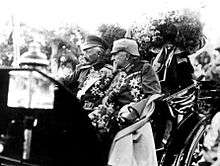
On 11 October 1915, the Bulgarian army attacked Serbia after signing a treaty with Austria-Hungary and Germany stating that Bulgaria would gain the territory it sought at the expense of Serbia. Ferdinand was not an admirer of German Emperor Wilhelm II (his second cousin once removed) or Austrian Emperor Franz Josef I whom he described as "that idiot, that old dotard of a Francis Joseph".[11] However, Ferdinand wanted additional territorial gains after the humiliation of the Balkan Wars. This also entailed forming an alliance with his former enemy, the Ottoman Empire.
During the initial phase of World War I, the Kingdom of Bulgaria achieved several decisive victories over its enemies and laid claim to the disputed territories of Macedonia after Serbia's defeat. For the next two years, the Bulgarian army shifted its focus towards repelling Allied advances from nearby Greece. They were also partially involved in the 1916 conquest of neighboring Romania, now ruled by another Ferdinand I, who was also Ferdinand's second cousin once removed.
To save the Bulgarian throne, Tsar Ferdinand abdicated in favour of his eldest son, who became Tsar Boris III on 3 October 1918.[12] Under new leadership, Bulgaria surrendered to the Allies and, as a consequence, lost not only the additional territory it had fought for in the major conflict, but also the territory it had won after the Balkan Wars giving access to the Aegean Sea.[12]
Personal life

Ferdinand entered a marriage of convenience[13] with Princess Marie Louise of Bourbon-Parma, daughter of Robert I, Duke of Parma and Princess Maria Pia of Bourbon-Two Sicilies, on 20 April 1893 at the Villa Pianore in Lucca. The marriage produced four children:
Marie Louise died on 31 January 1899 after giving birth to her youngest daughter. Ferdinand did not think again about marriage until his mother, Princess Clémentine died in 1907. To satisfy dynastic obligations and to provide his children with a mother figure, Ferdinand married Eleonore Reuss of Köstritz, on 28 February 1908.[14] Neither romantic love or physical attraction played any role, and Ferdinand treated her as no more than a member of the household, and showed scant regard.[15]
In his private relations, Ferdinand was a somewhat hedonistic individual. Bisexual throughout his life, up until early middle age his inclination was more towards women.[16] He enjoyed affairs with a number of women of humble position, siring a number of illegitimate children whom he then supported financially.[15]
In his later life, rumours abounded of Ferdinand's trysts with lieutenants and valets. His regular holidays on Capri, then a popular holiday destination with wealthy gay men, were common knowledge in royal courts throughout Europe.[16] In 1895 an interview given by the embittered former Prime Minister, Stefan Stambolov to the Frankfurter Zeitung created a nine-day scandal across Europe, when he focused strongly on his personal witness of Ferdinand’s homosexual interests.[17]
Exile and death
After his abdication, Ferdinand returned to live in Coburg, Germany. He had managed to salvage much of his fortune and was able to live in some style.[18] He saw his being in exile simply as one of the hazards of kingship.[18] He commented, "Kings in exile are more philosophic under reverses than ordinary individuals; but our philosophy is primarily the result of tradition and breeding, and do not forget that pride is an important item in the making of a monarch. We are disciplined from the day of our birth and taught the avoidance of all outward signs of emotion. The skeleton sits forever with us at the feast. It may mean murder, it may mean abdication, but it serves always to remind us of the unexpected. Therefore we are prepared and nothing comes in the nature of a catastrophe. The main thing in life is to support any condition of bodily or spiritual exile with dignity. If one sups with sorrow, one need not invite the world to see you eat."[19] He was pleased that the throne could pass to his son. Ferdinand was not displeased with exile and spent much of his time devoted to artistic endeavors, gardening, travel and natural history.
However, he would live to see the collapse of everything he had held to be precious in life.[19] His eldest son and successor, Boris III, died under mysterious circumstances after returning from a visit to Hitler in Germany in 1943. Boris III's son, Simeon II, succeeded him only to be deposed in 1946, ending the Bulgarian monarchy. The Kingdom of Bulgaria was succeeded by the People's Republic of Bulgaria, under which Ferdinand's other son, Kyril, was executed. On hearing of Kyril's death he said, "Everything is collapsing around me."[20]
Ferdinand died a broken man in Bürglaß-Schlösschen on 10 September 1948 in Coburg, Germany, cradle of the Saxe-Coburg-Gotha dynasty. He was the last surviving grandchild of Louis-Philippe of France. His final wish was to be buried in Bulgaria, and for this reason his coffin was temporarily placed in the crypt of St. Augustin, Coburg, next to his parents' coffins.
Titles, styles and honours
| Styles of King Ferdinand I of Bulgaria | |
|---|---|
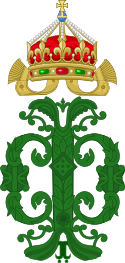 | |
| Reference style | His Majesty |
| Spoken style | Your Majesty |
| Alternative style | Sir |
Titles and styles
- 26 February 1861 - 7 July 1887: His Serene Highness Prince Ferdinand of Saxe-Coburg and Gotha, Duke of Saxony
- 7 July 1887 – 5 October 1908: His Serene Highness The Prince of Bulgaria
- 5 October 1908 - 3 October 1918: His Majesty The King of the Bulgarians
- Domestic
- Grand Master of the following Bulgarian Orders:
- Foreign honours
-
.svg.png) Albanian Royal Family: Knight with Collar of the Order of Albania[21]
Albanian Royal Family: Knight with Collar of the Order of Albania[21] -
.svg.png) Albanian Royal Family: Knight Grand Cross of the Order of Fidelity, Special Class[21]
Albanian Royal Family: Knight Grand Cross of the Order of Fidelity, Special Class[21] -
.svg.png) Austro-Hungarian Imperial and Royal Family: Knight with Collar of the Austrian Order of the Golden Fleece[22][23]
Austro-Hungarian Imperial and Royal Family: Knight with Collar of the Austrian Order of the Golden Fleece[22][23] -
.svg.png) Austro-Hungarian Imperial and Royal Family: Knight Grand Cordon with Collar of the Military Order of Maria Theresa[22]
Austro-Hungarian Imperial and Royal Family: Knight Grand Cordon with Collar of the Military Order of Maria Theresa[22] -
.svg.png) Austro-Hungarian Imperial and Royal Family: Knight Grand Cordon with Collar of the Order of Saint Stephen of Hungary[22]
Austro-Hungarian Imperial and Royal Family: Knight Grand Cordon with Collar of the Order of Saint Stephen of Hungary[22] -
.svg.png) Austro-Hungarian Imperial and Royal Family: Recipient of the Military Merit Cross, 3rd Class
Austro-Hungarian Imperial and Royal Family: Recipient of the Military Merit Cross, 3rd Class -
.svg.png) Belgium: Knight Grand Cordon of the Order of Leopold[24]
Belgium: Knight Grand Cordon of the Order of Leopold[24] -
.svg.png) Brazilian Imperial and Royal Family: Knight Grand Cordon with Collar of the Order of the Rose[24]
Brazilian Imperial and Royal Family: Knight Grand Cordon with Collar of the Order of the Rose[24] -
 Denmark: Knight Grand Cross with Collar of the Order of the Elephant
Denmark: Knight Grand Cross with Collar of the Order of the Elephant - France
-
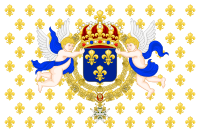 Orléans-French Royal Family: Knight Grand Cross of the Order of Saint Michael[22]
Orléans-French Royal Family: Knight Grand Cross of the Order of Saint Michael[22] -
 Orléans-French Royal Family: Knight Grand Cross with Collar of the Order of Saint Lazarus
Orléans-French Royal Family: Knight Grand Cross with Collar of the Order of Saint Lazarus -
 France: Grand Cross of the Order of the Legion of Honour[25]
France: Grand Cross of the Order of the Legion of Honour[25]
-
-
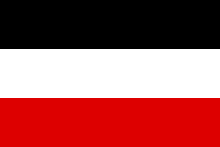 German Imperial and Royal Family: Knight Grand Cordon with Collar of the Order of the Black Eagle[26][27]
German Imperial and Royal Family: Knight Grand Cordon with Collar of the Order of the Black Eagle[26][27] -
 German Imperial and Royal Family: Knight Commander of the Imperial Military Order of the Iron Cross[22]
German Imperial and Royal Family: Knight Commander of the Imperial Military Order of the Iron Cross[22] -
 German Imperial and Royal Family: Knight of the Imperial Order of Merit
German Imperial and Royal Family: Knight of the Imperial Order of Merit
-
.svg.png) Bavarian Royal Family: Knight Grand Cross of the Military Order of Max Joseph
Bavarian Royal Family: Knight Grand Cross of the Military Order of Max Joseph -
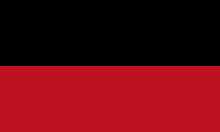 Württemberg Royal Family: Knight Grand Cross of the Order of Military Merit[28]
Württemberg Royal Family: Knight Grand Cross of the Order of Military Merit[28]
-
-
_crowned.svg.png) Italian Royal Family: Knight Grand Collar of the Supreme Order of the Most Holy Annunciation[25][29]
Italian Royal Family: Knight Grand Collar of the Supreme Order of the Most Holy Annunciation[25][29] -
_crowned.svg.png) Italian Royal Family: Knight Grand Cordon of the Order of Saints Maurice and Lazarus[25][29]
Italian Royal Family: Knight Grand Cordon of the Order of Saints Maurice and Lazarus[25][29] -
_crowned.svg.png) Italian Royal Family: Knight Grand Cordon of the Order of the Crown of Italy
Italian Royal Family: Knight Grand Cordon of the Order of the Crown of Italy
-
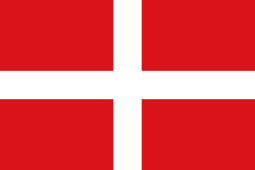 Sovereign Military Order of Malta: Bailiff Knight Grand Cross of Justice of the Sovereign Military Order of Malta, 1st Class[22][30][31][32]
Sovereign Military Order of Malta: Bailiff Knight Grand Cross of Justice of the Sovereign Military Order of Malta, 1st Class[22][30][31][32] -
.svg.png) Calabrian Royal Family of Two Sicilies: Knight Grand Cross of the Order of Saint Januarius
Calabrian Royal Family of Two Sicilies: Knight Grand Cross of the Order of Saint Januarius -
.svg.png) Royal Family of Two Sicilies: Knight Grand Cross with Collar of the Two Sicilian Sacred Military Constantinian Order of Saint George
Royal Family of Two Sicilies: Knight Grand Cross with Collar of the Two Sicilian Sacred Military Constantinian Order of Saint George -
 Parmese Ducal Royal Family: Knight Grand Cross of the Parmese Sacred Military Constantinian Order of Saint George
Parmese Ducal Royal Family: Knight Grand Cross of the Parmese Sacred Military Constantinian Order of Saint George
-
-
.svg.png) Kingdom of Portugal: Knight Grand Cross with Collar of the Order of Christ[24]
Kingdom of Portugal: Knight Grand Cross with Collar of the Order of Christ[24] -
.svg.png) Kingdom of Portugal: Knight Grand Cross with Collar of the Order of Aviz[24]
Kingdom of Portugal: Knight Grand Cross with Collar of the Order of Aviz[24] -
.svg.png) Kingdom of Portugal: Knight Grand Cross with Collar of the Military Order of Saint James of the Sword[24]
Kingdom of Portugal: Knight Grand Cross with Collar of the Military Order of Saint James of the Sword[24] -
 Russian Imperial Family: Knight Grand Cordon with Collar of the Imperial Order of Saint Andrew
Russian Imperial Family: Knight Grand Cordon with Collar of the Imperial Order of Saint Andrew -
 Russian Imperial Family: Knight Grand Cordon of the Imperial Order of Saint Prince Alexander Nevsky
Russian Imperial Family: Knight Grand Cordon of the Imperial Order of Saint Prince Alexander Nevsky -
 Russian Imperial Family: Knight Grand Cordon of the Imperial Order of the White Eagle
Russian Imperial Family: Knight Grand Cordon of the Imperial Order of the White Eagle -
 Russian Imperial Family: Knight Grand Cordon of the Imperial Order of Saint Prince Vladimir
Russian Imperial Family: Knight Grand Cordon of the Imperial Order of Saint Prince Vladimir -
 Russian Imperial Family: Knight Grand Cordon of the Imperial Order of Saint Anna
Russian Imperial Family: Knight Grand Cordon of the Imperial Order of Saint Anna -
.svg.png) Spanish Royal Family: Knight Grand Commander of the Order of Calatrava[25]
Spanish Royal Family: Knight Grand Commander of the Order of Calatrava[25] -
 Sweden: Knight Grand Cross with Collar of the Order of the Seraphim
Sweden: Knight Grand Cross with Collar of the Order of the Seraphim -
 Turkish Imperial Family: Knight Grand Cordon of the Order of the Crescent
Turkish Imperial Family: Knight Grand Cordon of the Order of the Crescent -
 United Kingdom: Knight Grand Cross of the Royal Victorian Order
United Kingdom: Knight Grand Cross of the Royal Victorian Order -
 United Kingdom: Recipient of the Queen Victoria Diamond Jubilee Medal
United Kingdom: Recipient of the Queen Victoria Diamond Jubilee Medal
Honorary military appointments
-
 Russian Empire: Colonel of the 54th Minsk Regiment – 1902[33]
Russian Empire: Colonel of the 54th Minsk Regiment – 1902[33]
Ancestors
References
- ↑ Louda, 1981, Lines of Succession, Table 149
- ↑ Archiv der Domkirche St. Stephan,Wien, Taufbuch 1860-1865
- 1 2 Finestone, 1981, The Last Courts of Europe, p 227
- 1 2 3 4 Louda, 1981, Lines of Succession, p 297
- 1 2 Aronson, 1986, Crowns In Conflict, p 83
- ↑ Aronson, 1986, Crowns In Conflict, pp 8–9
- ↑ Aronson, 1986, Crowns In Conflict, p 7
- ↑ "King up in Aeroplane: Ferdinand of Bulgaria First Monarch to Do It – Sons Fly Also" (Adobe Acrobat). New York Times website. New York Times. 16 July 1910. p. 1. Retrieved 2010-07-17.
- ↑ Aronson, 1986, Crowns In Conflict, p 86
- ↑ Aronson, 1986, Crowns In Conflict, p 87
- ↑ Aronson, 1986, Crowns In Conflict, p 126
- 1 2 Palmer, 1978, The Kaiser, p 206
- ↑ Constant, 1986, ‘’Foxy Ferdinand’’, p 143
- ↑ Aronson, p 85.
- 1 2 Stéphane Groueff, ‘’Crown of Thorns: The Reign of King Boris III of Bulgaria, 1918-1943’’, Madison Books, 1998.
- 1 2 Constant, Stephen ‘’Foxy Ferdinand, 1861-1948, Tsar of Bulgaria’’, Sidgwick and Jackson, 1979, p 96, p266.
- ↑ Perry, Duncan M. Stefan Stambolov and the Emergence of Modern Bulgaria: 1870-1895, Duke University, 1993, p216.
- 1 2 Aronson, 1986, Crowns In Conflict, p 201
- 1 2 Aronson, 1986, Crowns In Conflict, p 175
- ↑ Aronson, 1986, Crowns In Conflict, p 202
- 1 2 Wikimedia.org, Ferdinand wearing the Collar and largest star
- 1 2 3 4 5 6 Wikimedia.org, Photo of Ferdinand wearing French, Austrian, Italian, and German honours
- ↑ http://i42.tinypic.com/2vbagbs.jpg
- 1 2 3 4 5 Alamy.com, sketch of Ferdinand wearing the Belgian, Portuguese and Brazilian honours
- 1 2 3 4 Wikimedia.org, Photo1 of Ferdinand wearing the Italian, Spanish and French honours
- ↑ https://upload.wikimedia.org/wikipedia/commons/7/7f/2606493.jpg
- ↑ http://www.ww1-propaganda-cards.com/images/bulgaria4v.JPG
- ↑ "Ferdinand wearing the order at the wedding of his daughter Princess Nadezhda to Prince Albrecht of Württemberg".
- 1 2 Wikimedia.org, Photo1 of Ferdinand wearing the Italian honours
- ↑ http://www.kingsimeon.bg/wp-content/gallery/gallery-106/gallery-106_034.jpg
- ↑ "The Majesties attended the celebrations of the 900th anniversary of the Sovereign Order of Malta". The Majesties attended the celebrations of the 900th anniversary of the Sovereign Order of Malta - H.R.H. King Simeon II.
- ↑ "The Royal family attended the reception on the occasion of the Day of St. John the Baptist, patron of the Order of Malta". The Royal family attended the reception on the occasion of the Day of St. John the Baptist, patron of the Order of Malta - H.R.H. King Simeon II.
- ↑ "Prince ferdinand at Kieff". The Times (36805). London. 27 June 1902. p. 7.
External links
| Wikimedia Commons has media related to Ferdinand I of Bulgaria. |
- Works by or about Ferdinand I of Bulgaria at Internet Archive
- Historical photographs of the royal palace in Sofia
- Encyclopædia Britannica
Books
- Aronson, Theo (1986). Crowns In Conflict: The Triumph And The Tragedy Of European Monarchy, 1910–1918. London: J.Murray. ISBN 0-7195-4279-0.
- Constant, Stephen (1986). Foxy Ferdinand, 1861–1948, Tsar of Bulgaria. London: Sidgwick and Jackson. ISBN 0-283-98515-1.
- Louda, Jiri; Michael Maclagan (1981). Lines of Succession. London: Orbis Publishing Ltd. ISBN 0-460-04519-9.
- Massie, Robert K (1981). The Last Courts of Europe. London: J.M.Dent & Sons Ltd. ISBN 0-460-04519-9.
- Palmer, Alan (1978). The Kaiser: Warlord Of The Second Reich. London: Weidenfeld and Nicolson. ISBN 0-297-77393-3.
| Ferdinand I of Bulgaria Cadet branch of the House of Wettin Born: 26 February 1861 Died: 10 September 1948 | ||
| Regnal titles | ||
|---|---|---|
| Preceded by Alexander I |
Prince of Bulgaria 7 July 1887 – 5 October 1908 |
Proclaimed Tsar Bulgarian independence from Ottoman Empire |
| New title |
Tsar of Bulgaria 5 October 1908 – 3 October 1918 |
Succeeded by Boris III |
| Political offices | ||
| Preceded by Alexander I |
Governor-general of Eastern Rumelia 7 July 1887 – 5 October 1908 |
proclaimed Tsar Bulgarian independence from Ottoman Empire |
| Bulgaria during World War I | |||
|---|---|---|---|
| Prelude | South-western front Serbian Campaign, Macedonian Front |
Romanian front • Outcome • Others | Important persons |
|
1912–1913 1913 Neutrality
1914 1915
 |
Commanders
Nikola Zhekov • Kliment Boyadzhiev • Dimitar Geshov • Georgi Todorov • Ivan Lukov • Stefan Nerezov • Vladimir Vazov
Field Armies
Battles
1915 Morava Offensive • Ovče Pole Offensive • Kosovo Offensive (1915) • Battle of Krivolak 1916 First battle of Doiran • Battle of Florina (Lerin) • Struma operation • Monastir Offensive 1917 Second battle of Doiran • 2nd Crna Bend • Second battle of Monastir 1918 Battle of Skra-di-Legen • Battle of Dobro Pole • Third battle of Doiran |
Commanders
Nikola Zhekov • Panteley Kiselov • Stefan Toshev • Todor Kantardzhiev • Ivan Kolev
Field Armies
Battles
1916 Battle of Turtucaia • Battle of Dobrich • First Cobadin • Flămânda Offensive • Second Cobadin • Battle of Bucharest Outcome
1918 Treaty of Brest-Litovsk • Armistice of Focșani • Treaty of Bucharest • Protocol of Berlin Outcome
Others
|
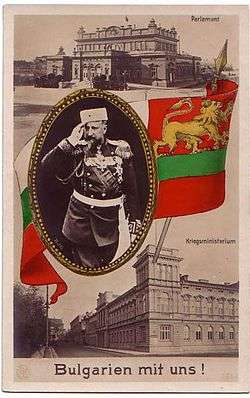
|